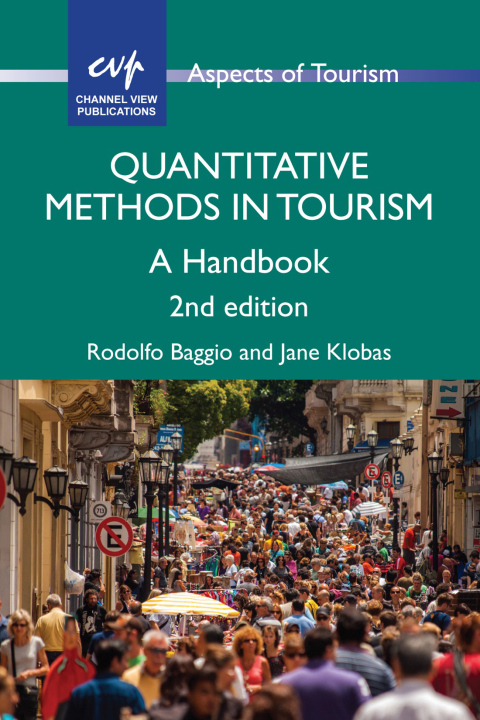Description
Efnisyfirlit
- Cover-Page
- Half-Title
- Series
- Title
- Copyright
- Contents
- Contributors
- Foreword
- Introduction to the Second Edition
- Introduction
- Part 1: The Analysis of Data
- 1 The Nature of Data in Tourism
- Data: A Taxonomy
- Primary data
- Secondary data
- Combining primary and secondary data
- Data Harmonisation, Standards and Collaboration
- Quantitative and categorical data
- The many forms of data
- Data Quality
- Data screening and cleaning
- Why screen data?
- Concluding remarks
- Sources of Secondary Tourism Data
- International organisations
- Associations
- Private companies
- References
- 2 Testing Hypotheses and Comparing Samples
- Parametric and Non-Parametric Tests
- Effect Size and Statistical Power
- Sample Size and Significance
- Bootstrap
- Meta-analysis
- A Summary of Statistical Tests
- Similarity and Dissimilarity Measures
- Similarity measures for a single sample
- Similarity measures for two or more samples
- Mahalanobis Distance and Multivariate Outlier Detection
- References
- 3 Data Reduction
- Factor Analysis
- Techniques for exploratory factor analysis
- Choosing the number of factors to extract
- Selecting variables
- Rotation and interpretation of factors
- Using the Results of a Factor Analysis
- Data Considerations and Other Issues in Factor Analysis
- Cluster Analysis
- How cluster analysis works
- Using distance measures to represent similarity and difference in cluster analysis
- Partitioning
- Hierarchical cluster analysis
- Evaluating and improving cluster analysis solutions
- Multidimensional Scaling and Correspondence Analysis
- References
- 4 Model Building
- Simple Regression
- The regression equation
- Initial inspection of the data: Is there evidence of a linear relationship?
- A Solution for Non-Linearity: Transformation
- Measuring the quality of the linear regression model
- The statistical significance of the regression model
- Assumptions that must be met for a valid linear regression model
- Assessing the Validity of Assumptions
- More pitfalls: Influential values and outliers
- The extrapolation limitation
- Multiple Regression
- Modelling categorical variables
- Assessing the quality of a multiple regression model
- The multicollinearity problem
- Choosing a multiple regression model
- Logistic Regression
- The logistic regression model
- Assumptions of logistic regression
- Interpreting and reporting the results of logistic regression analyses
- Evaluating the quality of a logistic regression model
- Path Modelling
- Comparing SEM and PLS
- The language of covariance-based structural equation modelling
- Specifying a structural equation model
- Basic operations of SEM
- Measuring the fit of a structural equation model
- Assumptions of SEM and associated issues in estimation
- Measurement models and structural models
- Dealing with small samples
- Mediation and Moderation in Model Building
- Mediation
- Moderation
- Multilevel Modelling
- Hierarchically structured data
- Testing for multilevel effects
- Modelling multilevel effects
- Multilevel Regression Models
- Multi-Group Analysis in Structural Equation Modelling
- Common Method Variance: A Special Case of Multilevel Variance
- The effects of CMV
- Techniques for identification and remediation of CMV
- References
- 5 Time-Dependent Phenomena and Forecasting
- Basic Concepts of Time Series
- Smoothing methods
- Autoregressive integrated moving average models
- Filtering Techniques
- Hodrick–Prescott filter
- Comparing Time Series Models
- Combining Forecasts
- Correlation between Series
- Stationarity, Stability and System Representations
- Predictability
- Non-linearity (BDS test)
- Long-range dependency (Hurst exponents)
- References
- Part 2: Numerical Methods
- 6 Maximum Likelihood Estimation
- Estimating Statistical Parameters
- Likelihood Ratio Test
- References
- 7 Monte Carlo Methods
- Numerical Experiments
- Random and Pseudorandom Numbers
- References
- 8 Big Data
- Technology
- Data collection tools
- Some Statistical Remarks
- Artificial Intelligence and Machine Learning
- Supervised learning
- Unsupervised learning
- Concluding Remarks
- References
- 9 Simulations and Agent-Based Modelling
- Complex Adaptive Systems and Simulations
- Agent-Based Models
- Issues with Agent-Based Models
- Evaluation of an Agent-Based Model
- ABM and Tourism
- Concluding Remarks
- References
- Appendix: Software Programs
- Software List
- Statistical Packages
- Generic packages
- Specialised programs cited in this book
- Development environments and programming languages
- References
- Subject Index






Reviews
There are no reviews yet.